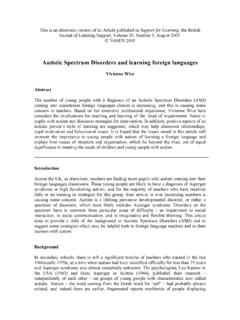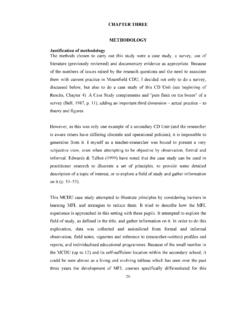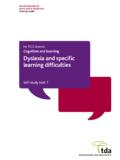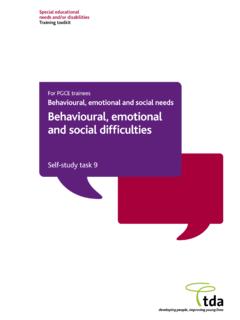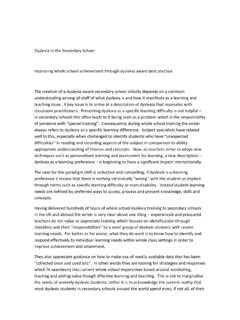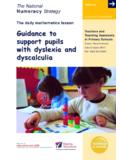Transcription of FOREIGN LANGUAGE LEARNING AND DYSLEXIA …
1 FOREIGN LANGUAGE LEARNING AND DYSLEXIA margaret Crombie This article is adapted from a previous article Bad LANGUAGE or Good , first published in the DYSLEXIA Yearbook in 1999. FOREIGN LANGUAGE LEARNING presents young people today with the opportunity to communicate with non-English speaking peers on equal terms: to use the gift of communication to promote a common understanding and share visions and plans for the future. It is not simply an ideological educational theory designed to gain acceptance of a common curriculum for schools. However if we are to promote the idea of FOREIGN LANGUAGE LEARNING for all, we must question if it is really possible to give all our young people access to this area of the curriculum and if we can make the experience a worthwhile one which results in effective LEARNING .
2 If we can answer, Yes to this question, then the next question will inevitably be HOW ? Why should dyslexic students learn another LANGUAGE ? For dyslexic students who have struggled to learn their own LANGUAGE , and who may still be coming to terms with the finer points of reading and writing, we must ensure we are not imposing an unbearable burden that could result in further failure, demotivation and subsequent behaviour problems. True inclusion in the modern languages classroom is about much more than having a presence and being exposed to another LANGUAGE . It is about feeling accepted and involved in a worthwhile LEARNING experience whatever the level that can be achieved.
3 The benefits of LEARNING another LANGUAGE are fairly clear: an extended range of employment and recreational opportunities, as well as the less tangible benefits of achieving a closer understanding of others by communicating in the other LANGUAGE instead of just their own. By depriving any young people of such opportunities, we may create the anxiety we seek to avoid. Should all dyslexic students study another LANGUAGE ? One dilemma which we face is whether we should present all young people with a common modern LANGUAGE curriculum irrespective of any additional support needs which they may have, or deprive students of what may prove to be a worthwhile and satisfactory LEARNING experience.
4 The difficulty in solving the dilemma is one that permeates educational practice. All young people are not the same, and all dyslexic young people are not the same! Because one young dyslexic person succeeds dos not mean every dyslexic young person will. What works for one may not work for another. Early research into the LEARNING of another LANGUAGE suggested that because dyslexic children normally manage to cope with the spoken and listening aspects of their own LANGUAGE , there was no reason whey they would not cope with a FOREIGN LANGUAGE . This has not generally proved to be the case however as my own research has found (Crombie, 1995; 1997; 2003).
5 The environment in which dyslexic pupils learn their own LANGUAGE is generally quite different from the classroom conditions which most children experience in the teaching and LEARNING situation. Total immersion which exists for children LEARNING English in English speaking schools, does not exist m many classrooms, and it is only when children attend specific LANGUAGE schools or go to live in another country that they have a chance of reaching anywhere near the level of immersion which they had for their first LANGUAGE . The age at which immersion takes place too may be a critical factor in producing the most favourable climate for LEARNING . There are few schools which teach FOREIGN languages to children under the age of eight.
6 Trying to anticipate LEARNING abilities The level of a child s difficulties in English LANGUAGE may give an indication of the likely difficulties in FOREIGN LANGUAGE LEARNING , but it is certainly not he only indicator. Motivation, attitude, LEARNING style, self esteem and determination are as always crucial to LEARNING . If we can convince young people to believe in themselves, we may make the difference between success and failure. Even when all the motivational and attitudinal conditions are right, there is still the possibility that we may not succeed in achieving the LEARNING we hoped. Because of the phonological difficulties which the vast majority of dyslexic pupils exhibit, there are likely to be problems with the phonology or the new LANGUAGE .
7 Auditory discrimination may be problematic. There are other reasons too why dyslexic pupils differ in their LEARNING abilities. Processing time is a crucial factor. The fact that dyslexic pupils often take more time to process LANGUAGE information is one which has been substantiated by research (Ackerman & Dykman, 1996). We cannot therefore expect dyslexic pupils to absorb information at the same pace as their peers. Slowing the pace at which we expect dyslexic pupils to speak or listen in the FOREIGN LANGUAGE may not be exactly natural but it does give the dyslexic student time to process during the initial stages of LEARNING . Working memory and short-term memory difficulties that affect dyslexic pupils LEARNING could be expected to affect FOREIGN LANGUAGE LEARNING .
8 If a young person has difficulty in accessing a word such as hospital and instead says, hopsital , this muddling of polysyllabic words which is not unexpected in dyslexic people generally is likely to overlap into the new LANGUAGE . Short-term memory difficulties make it likely that LEARNING vocabulary too will pose problems for the dyslexic learner. Combined with the extra time required to access words from memory, the pupil may have problems in maintaining concentration for sufficient time to decode, comprehend and respond. This factor of requiring extra time may remain until the pupil reaches the stage of being able to think in the other LANGUAGE .
9 Pupils who have mild difficulties in LEARNING to read, write and master the phonology of their own LANGUAGE , may find some difficulty in tackling whatever FOREIGN LANGUAGE they choose, but will probably reach a reasonable standard if they persist. At the early stages of LEARNING the new LANGUAGE progress may be quite acceptable. However, as the demands rise, memory may become overloaded, and if the pupils do not understand the necessary strategies and techniques to employ, what was initially a pleasurable experience can become extremely stressful, with the possibility of breakdown not just in LEARNING but also in motivation and self-esteem. The Challenges for teachers For teachers, the challenge is to find the most effective methods of teaching FOREIGN languages to dyslexic pupils as well as all the others in the class.
10 Research from the United States which emphasises a systematic structured approach to a multisensory nature, suggests that this is the most effective method for poor LANGUAGE learners. This Multisensory Structured LANGUAGE (MSL) approach is described by Ganschow, Sparks & Schneider (1995) in the International DYSLEXIA Journal and for those who are interested in using these techniques the article is necessary reading. Methods The MSL approach is based on the work of Gillingham and Stillman (1960) and is not unlike the type of approach recommended for teaching first LANGUAGE skills to dyslexic students. Grammar, syntax, and LANGUAGE phonology require to be taught through a programme that emphasises hearing, seeing, speaking and writing the LANGUAGE .
